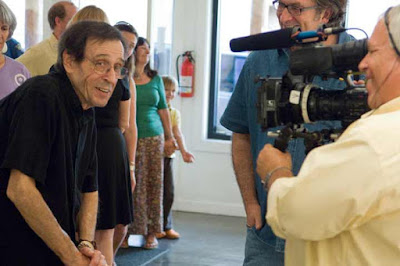 This Bill Epperidge.
This Bill Epperidge.You might not know his face or even his name, but you know his work.
So what’s wrong with this picture?
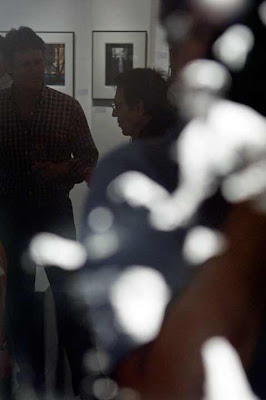 Epperidge, middle, is reflected in the glass of his framed photograph of presidential candidate Senator Robert F. Kennedy D-Mass., lying on the floor of the kitchen pantry of Los Angeles’ Ambassador Hotel, June 5, 1968, which he took for Life magazine, and is considered iconic. Busboy Juan Romero tried to help Kennedy after assassin Sirhan Sirhan, fired eight shots, striking Kennedy three times, one to the head from only an inch away.
Epperidge, middle, is reflected in the glass of his framed photograph of presidential candidate Senator Robert F. Kennedy D-Mass., lying on the floor of the kitchen pantry of Los Angeles’ Ambassador Hotel, June 5, 1968, which he took for Life magazine, and is considered iconic. Busboy Juan Romero tried to help Kennedy after assassin Sirhan Sirhan, fired eight shots, striking Kennedy three times, one to the head from only an inch away.Gov. Bill Richardson, an admirer of Bobby Kennedy, and New Mexico Secretary of Cultural Affairs Stuart Ashman, as they have before, stopped by early to view the display. Journal Photographer Roberto Rosales also took in the show.
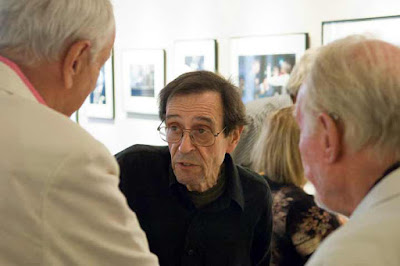 Two former colleagues of Epperidge dropped by, Senior Editor of LIFE Magazine Hal Wingo, left, and Richard "Dick" Stolley, right.
Two former colleagues of Epperidge dropped by, Senior Editor of LIFE Magazine Hal Wingo, left, and Richard "Dick" Stolley, right.Stolley may be best known at Life for having negotiated the purchase of the Abraham Zapruder film. Zapruder, was in Dallas’ Dealey Plaza on November 22, 1963 and filmed the only known movie of the assassination of President John F. Kennedy.
Wingo was Co-founder of PEOPLE Magazine while Stolley was the founding managing editor of People. They both now reside in Santa Fe.
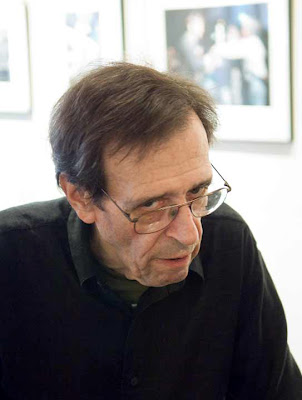 Epperidge raised his eyebrows as they moved on and said, “They were my bosses.”
Epperidge raised his eyebrows as they moved on and said, “They were my bosses.” There was a documentary videographer from by Muldaur Media taping for a segment of Epperidge’s taking the Kennedy assassination picture.
There was a documentary videographer from by Muldaur Media taping for a segment of Epperidge’s taking the Kennedy assassination picture. The following blurbs on the documentary were provided through Sidney Monroe:
"The Eye of the Storm" documents the assassination of Robert F. Kennedy through the eyes of five photojournalists who were at the Ambassador Hotel on the night of June 5th, 1968 to celebrate Bobby’s California Presidential Primary victory.UPI’s David Kennerly photographed Robert Kennedy just before the assassination; he was not in the kitchen. He won the 1972 Pulitzer Prize for Feature Photography.
For the first time, these five journalists (Bill Eppridge of Life Magazine, Boris Yaro of The Los Angeles Times, Ron Bennett of UPI, David Kennerly of UPI, Richard Drew of the Pasadena Star News) tell their story. No narration, no academics or experts, just five men who came to celebrate a victory and ended up recording a tragedy of enormous magnitude for our country. In a millisecond, these photographers had to turn on a dime and decide to shoot photographs of a mortally wounded man that they all had come to love.
 I photographed him during a presentation by Pulitzer winners at the National Press Photographers Association annual conference in 2000 in San Francisco. He jokingly remarked that he must have been the only one to receive the memo on the dress of the day, casual.
I photographed him during a presentation by Pulitzer winners at the National Press Photographers Association annual conference in 2000 in San Francisco. He jokingly remarked that he must have been the only one to receive the memo on the dress of the day, casual.If one Googles Robert Kennedy assassination images you may view many pictures on various sites.
Michelle Monroe offered to introduce me to Epperidge. I declined based on several factors: admirers swarmed him, I seldom make actual contact with my subjects, and I was invoking a theory of the anonymous quote.
When in the presence of greatness, silence is the highest form of respect.Epperidge's photo essay on heroin addicts inspired me to try to get closer to subjects of social ills. Of course, these opposing theories create a conundrum.
Anyone who has heard me speak about politics or just about any other topic might find it surprising that I try to work silently while photographing.
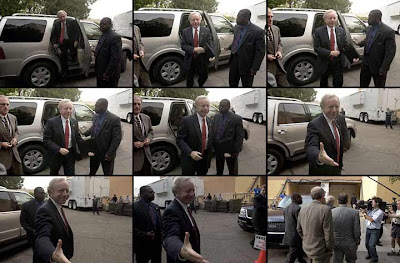 It's not my job to appear partisan or be drawn into a sociable response; it is my job to remain detached enough to fairly cover my subject. Sometimes it works, like here, where I didn't shake hands with Sen. Joe Lieberman, in 2003 when he was one of nine Democratic candidates campaigning for the Party's nomination, he is is now an Independent from Connecticut; sometimes it does not work.
It's not my job to appear partisan or be drawn into a sociable response; it is my job to remain detached enough to fairly cover my subject. Sometimes it works, like here, where I didn't shake hands with Sen. Joe Lieberman, in 2003 when he was one of nine Democratic candidates campaigning for the Party's nomination, he is is now an Independent from Connecticut; sometimes it does not work.I will let my photographs of Epperidge be my humble testament to the quality of his life’s work.
1 comment:
Mark, thanks for the Epperidge info. Last weekend I visited the Monroe Gallery to see that photo exhibit. Very fascinating body of work, the RFK photos were very moving.
Post a Comment